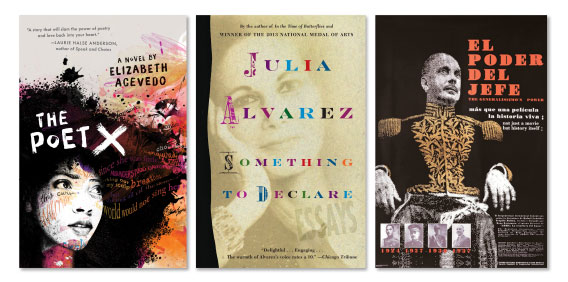6 Multimedia Resources for Teaching ‘How the Garcia Girls Lost Their Accents’ | Refreshing the Canon
SLJ and NCTE have revealed the 2023 round of “Refreshing the Canon” selections. Check out cross-media recs to enhance teens’ reading experience of Julia Alvarez’s How the Garcia Girls Lost Their Accents.

Last month, SLJ asked librarians and educators to weigh in on which classics should remain on summer reading lists. Inspired by the most popular titles that emerged, SLJ editors and members of NCTE’s Build Your Stack® Committee have curated this year’s round of “Refreshing the Canon” selections.
Additionally, we’ve put together multimodal lists of recommendations—including nonfiction, graphic novels, documentaries, and more—that educators can feature in classrooms and libraries alongside the exemplar texts. Our aim is to inspire educators to breathe fresh life into lessons around these works by giving students new context to understand why these classics are still relevant today.
Be sure to check out the 2022 “Refreshing the Canon” lists for more read-alikes of longtime summer reading picks.
Julia Alvarez’s debut How the Garcia Girls Lost Their Accents was first published in 1991. The coming-of-age novel centers the Garcia sisters, who experience culture shock when they flee to New York City from the Dominican Republic after their father’s part in a failed coup to oust a dictator comes to light. Since then, it has become a staple of high school summer reading lists.

Read-Alikes:
Dominicana by Angie Cruz. Flatiron. ISBN 9781250205933.
In mesmerizing prose, Cruz captures the heartbreaking coming of age of Ana Cancion. Based on Cruz’s mother’s story, the novel centers on 15-year-old Ana’s transactional marriage to the much-older Juan Ruiz and her immigration to the United States from the Dominican Republic in the 1960s, after dictator Rafael Trujillo’s assassination. With similar themes, this novel would be a great comparison title.
The Poet X by Elizabeth Acevedo. Harper/HarperTeen. ISBN 9780062662804.
Magnificently crafted, Acevedo's bildungsroman in verse is a stunning account of a teen girl's path to poetry. Sophomore Xiomara Batista is simultaneously invisible and hyper visible at home, at school, and in her largely Dominican community in Harlem—her body is "unhide-able" she tells readers. Acevedo's depiction of a faith in crisis is exceedingly relatable and teens, especially those going through the sacrament of Confirmation, will deeply appreciate Xiomara's thoughtful questioning of the Church and how it treats women. Acevedo's poetry is skillfully and gorgeously crafted, each verse can be savored on its own, but together they create a portrait of a young poet sure to resonate with readers. Patriarchy, loyalty, family, immigration are only a few themes that can be explored with these two texts.
Nonfiction:
Grose, Jaime. “The Psychology Behind Sibling Rivalry.” The New York Times. (New York, NY), Jan. 13. 2021.
This entry of the NYT Parenting column explores how sibling rivalry is inevitable and why it’s actually a good thing in helping siblings develop their own interests and identities. There are four Garcia girls, each with their own personalities, strengths, and differences. Teens can explore how this article illuminates some of the sisterly conflicts that come up in the novel.
Something to Declare by Julia Alvarez. Algonquin. ISBN 9781565121935.
The poet and novelist presents her personal experiences in two dozen pithy autobiographical essays that are by turn humorous, thoughtful, or frightening. Her literary skill converts them into universal moments. This book will delight her fans, attract new readers to her previous work, and open the possibility for discussions about experiences with emigration, immigration, growing apart from one's family, and discovering one's own career path and status as an adult.

Multimedia:
Luis Alberti’s Merengue Music
Alberti was a musician heralded by Dominican dictator Trujillo as one of the great composers of merengue, the country’s most popular musical genre. This music became popular in 1960s New York City with the influx of refugees from his regime. “Compadre Pedro Juan” is one of his most famous works.
Trujillo: The Power of the Generalissimo. 1991.
This documentary takes viewers on a journey through the political, economic, and social conditions that determined the emergence of the Trujillo dictatorship in the Dominican Republic. For this purpose, it uses materials of the time: photographs, documents, recordings of speeches by Trujillo and his close collaborators, as well as other spectacular audiovisual resources. This film will give students the context they need to understand why the Garcia family had to flee the Dominican Republic.
|
Resources curated by SLJ's Reviews Editors: Shelley Diaz, Andrew Eliopulos, Kimberly Fakih, Amanda Mastrull, Florence Simmons & Ashleigh Williams and NCTE’s Build Your Stack® Committee, an initiative focused exclusively on helping teachers build their book knowledge and their classroom libraries. Members include Jen Vincent, Seemi Aziz-Raina, Gary Gray, Jr., Jodi Hazel, Carol Jago, Kaie Papesh, Carrie M. Santo-Thomas, Kasey Short, and Aliza Werner.
|
RELATED
The job outlook in 2030: Librarians will be in demand
The job outlook in 2030: Librarians will be in demand
ALREADY A SUBSCRIBER? LOG IN
We are currently offering this content for free. Sign up now to activate your personal profile, where you can save articles for future viewing






Add Comment :-
Be the first reader to comment.
Comment Policy:
Comment should not be empty !!!